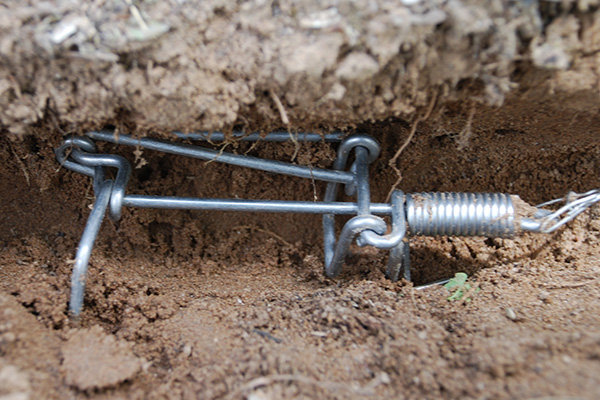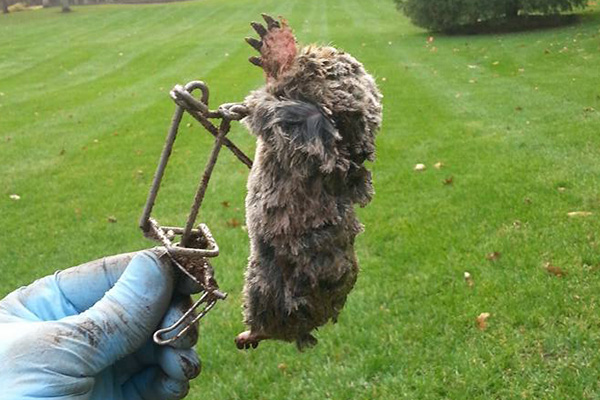-
info@aaanimalcontrol.com
Call us for help in your town
Humane Wildlife Education
How to prevent and keep moles away
Need mole removal in your hometown? We service over 500 USA locations! Click here to hire us in your town and check prices - updated for year 2020.
Moles can invade private residences, especially gardens and lawns and can create a permanent abode in such places. While the use of repellants such as Castor oil is common, such repellants will require a huge application in order to make it very effective. Repellants can be sprayed on lawns and tunnels that have direct link to lawns, gardens and other parts of the residence, however, such repellants may have limited applications during raining season as the rain will wash them away and their powers will be drastically reduced. Similar to repellants such as Castor oil, are moth balls , that can also be placed in tunnels and yards- these repellents may be very effective for a while but the stress of replacing such repellants can be a very difficult task for most people.
Need mole removal in your hometown? Click here for our nationwide list of hundreds of
wildlife removal experts, serving all 50 states!
The use of methods such as placing a bucket over the mole and then transporting it to another location, is only ideal if there are no serious infestations within your yard, lawn or garden.
Exclusion methods such as keeping grasses very low and hardening the soils around the property may help keep moles away. Moles prefer bushy areas where they can hide and burrow, however when the grasses are completely removed or kept too short, and the soil is hard, they will find it difficult to infest your area and migrate to another place. Rather than killing moles, it is ideal to use mechanic devices to trap them or repellants.

Catching moles alive, either with the use of buckets or non-lethal traps, seem to be the best possible way to get rid of them safely, once they are caught, you can then transfer them into cardboard boxes and report them to animal rehabilitation centers . when their activities are not controlled early, Moles may damage plants through their furrows, the animals are perfect in digging and can dig up to 1 feet of hole within a minute. The tunnels created by moles will lead to the death of many advantageous earthworms and your plants may be at risk of dying due to the destruction caused to the soil.
Since moles have poor eyesight, you can use that to your advantage and spray repellants on their tunnels, and your lawn. To do this, simply prepare the repellant by mixing 2 cups of castor oil with 2 tablespoon of dish-washing soap. And both mixed with about a gallon of water. Try as much as possible to apply weekly , but after rainfall( if you stay in regions where rainfall are prominent). Alternatively, you can plant garlic or chocolate lily to scare away moles, because they don’t like the smell of such plants.

Lethal traps like the above pictured pinching or paper clip trap are the most effective ways of getting rid of moles. read about mole trapping. The trap must be a body-gripping one, so that the mole will not escape by dragging the trap far from its position. Simply locate the tunnels used by moles, and then flatten before pushing the soil , to cover the trap slightly. You may also place the live trap at the entrance of the tunnel and then cover it with some soil or leaves. Once a mole step on the trigger of the trap, the animal automatically gets caught.
Spring traps are usually the best form of traps you can use in catching moles, and the reason being that such traps can automatically reset. Make sure you set the spring trap after leveling the tunnel created by a mole. As the mole tries to re-burrow the tunnel, the trap automatically shuts the animal . To make your trap even more effective, you can make use of a bait( the bait should resemble a earthworm, because moles love earthworms more than other kinds of foods). Aside a bait that looks like earthworm, you can also make use of a poisoned peanut as a bait. When using poisoned peanut as a bait, make sure your dogs and cats do not have access to the trap.
Exclusion methods such as the use of Ultrasonic vibration devices powered by batteries, as well as exclusion fences that must be dug at not less than 3 feet below the ground, can also be used to get rid of moles. The use of vibration devices, can create fear in the minds of moles that a predator is fast approaching thus the animal will relocate by itself. Exclusion fences that can be dug into the ground will also ensure that the animal does not burrow underneath the fence and get access to the property.
Methods such as poisoning and shooting of moles are not recommended considering the hazards posed by such methods on humans and other animals. Shooting for instance is not recommended where moles have become endemic, likewise poisoning moles is not recommended because they may not die instantly, and if they die somewhere else, their carcass may constitute environmental hazards to the public. Changing your landscape is probably one of the best possible ways to prevent mole invasion- this means you need to keep grasses and lawns very short, or grow plants that moles will naturally detest. Moles have poor eyesight and smell, thus, you must use such to your advantage in getting rid of them.
Learn how to kill a mole.
Go back to the main how to get rid of moles page for better information about mole prevention and how to keep moles away.
Need wildlife removal in your town? Now serving over 500 US locations - updated for 2018
When you have moles in your yard, you know it’s because you have earthworms too. Every garden will have insects, bugs and worms in it, but the more you have, the more of these larger predators you’re likely to attract. When you're talking about any wild animal, it’s almost aways food that brings them closer. Even when the creature is just looking for a new home, it will be the scent of food that brought them to your property in the first place.

If you know that the mole’s main food source is the earthworm, this can give you an idea of how to solve a mole problem. These velvety creatures may feel soft and seem harmless, but they have the potential to wreak absolute havoc, and to cause destruction that can cost in the thousands to repair.
Again, when dealing with any nuisance wildlife, the best way to deal with the problem and to prevent it from coming back is to make your land as unfriendly as possible. Well-watered land will draw in earthworms, and that’s when the moles will come too. As much as you may want to have a beautifully green and lush lawn this summer, all that watering and lushness will come at a price. You should look at watering your garden or land less frequently, bringing in fewer earthworms, thus attracting fewer moles.
At the same time, you could always look at adding something to your water to make the land unsuitable for insects, such as insecticides. You can buy both natural and chemical versions of this now, and it is generally considered that the friendlier, more natural products are the ones that are safest to use. When you're spraying chemicals around in your back yard, you have the potential to contaminate water sources, food, growing soil, and more. You also don't know the direct effect that chemical mix could have on the wildlife around you.
If you have a relatively small space to protect, such as a small back yard, one of the easiest things that you can do is to add an underground fence that goes around the entirety of the space. This works in much the same way as adding a fence around your back yard to stop stray dogs from coming in (and also to stop the kids from escaping), except you’re protecting your land from the animals that can easily make their way past the overground barriers. There is a lot of nuisance wildlife that use digging as a way to enter your property, so by adding this underground layer of protection, you can ensure that yours is an animal-free as it can be.
Mesh wire or hardware cloth are perfect for this kind of job, but you will want to make sure that you're going between one to two foot down in the ground. The deeper you go, the better protection that fence will offer you. Once everything is in place, you simple fill up the holes you made to put the wiring down there in the first place, a make sure you check it every now and again. If you do spot an patch of damage, you can repair it before it becomes a problem, rather than waiting for it to become a problem and then trying to get rid of a stubborn wild critter.
If you didn’t want to go down the route of adding an underground fence, you could look at adding an underground pit of gravel instead. It works in the same way — it provides you with a physical barrier. The gravel provides a material that the mole will find it hard to dig its way through, and will, therefore, likely give up and more on fairly quickly.
Pets can have some effect on keeping out wild critters, although we do not suggest getting a cat or a dog for the sole purpose of keeping them out. In many cases, wild animal and domesticated pet conflicts can end in disaster, and when you don't have the physical threat of attack to worry about, there is always the threat of disease. Despite that, moles have a pretty serious disliking to cats and dogs, especially once they start sniffing and digging around in their tunnels. You may find that when a dog moves in, the mole moves right out. If you already have household pets and still find that you have a mole problem, you are the classic example of why pets shouldn't be used to deter wild animals. That's generally the one time it doesn't work.
There are a few natural remedies that you can use, passed down through the generations. We have heard of countless natural mole repellents, and these include chocolate lilies, garlic, and even spicy/hot food, such as cayenne pepper. These can have some success, but repellents generally do not work that effectively when they are used alone. You could always try using a castor-oil based repellent, which many homeowners seem to swear by on the internet. We can't personally say that we’ve had the greatest success with this.
There are plenty of approaches that you could take when it comes to keeping out nuisance wildlife, such as moles, but the old-fashion approach is often the easiest one. Trapping can be used to get these creatures out once they have already moved in, but prevention is so much better than cute. By making sure you have underground fences or gravel pits, and you’re keeping your back yard or property food-free, you’re making a very good start.
For more information, you may want to click on one of these guides that I wrote:
How to Get Rid of Moles
how much does mole removal cost?
How to get rid of moles in yard with juicy fruit gum


















